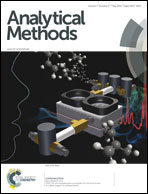Quantitative characterization of histone post-translational modifications using a stable isotope dimethyl-labeling strategy†
Abstract
Histone post-translational modifications (PTMs) have been considered to be a major group of important epigenetic marks and play critical roles in the regulation of chromatin-templated biological processes. To date, novel strategies for the quantification of histone PTMs are still highly desirable. Herein, we present an efficient approach to quantitatively characterize histone PTMs using stable isotope dimethyl labeling coupled with mass spectrometry. At first, all of the ε-amino groups of free lysines are derivatized by heavy formaldehyde to enable an easy distinction of free lysines from those of naturally occurring lysine-dimethylation upon MS analysis. After tryptic digestion, a second derivatization was applied with heavy- and light-stable isotope dimethyl labeling to label the N-termini of tryptic peptides from different sample sources. The mixture was further identified and quantified by HPLC-MS/MS. This method enables the comparison of histone PTMs from multiple sample sources and the quantification of different PTMs at certain amino-acid residues of histones in one single experiment. Thus, it is highly attractive for the identification of epigenetic histone marks.


 Please wait while we load your content...
Please wait while we load your content...